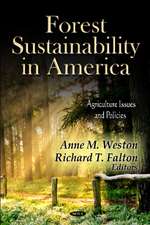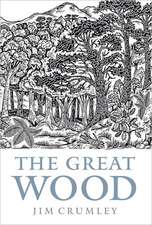Biological Nitrogen Fixation and Beneficial Plant-Microbe Interaction
Editat de Fernando González-Andrés, Euan Jamesen Limba Engleză Hardback – 2 iun 2016
| Toate formatele și edițiile | Preț | Express |
|---|---|---|
| Paperback (1) | 1033.08 lei 38-44 zile | |
| Springer International Publishing – 30 mai 2018 | 1033.08 lei 38-44 zile | |
| Hardback (1) | 1049.92 lei 38-44 zile | |
| Springer International Publishing – 2 iun 2016 | 1049.92 lei 38-44 zile |
Preț: 1049.92 lei
Preț vechi: 1381.47 lei
-24% Nou
Puncte Express: 1575
Preț estimativ în valută:
200.97€ • 218.37$ • 168.92£
200.97€ • 218.37$ • 168.92£
Carte tipărită la comandă
Livrare economică 18-24 aprilie
Preluare comenzi: 021 569.72.76
Specificații
ISBN-13: 9783319325262
ISBN-10: 3319325264
Pagini: 250
Ilustrații: X, 249 p. 43 illus., 16 illus. in color.
Dimensiuni: 155 x 235 mm
Greutate: 0.64 kg
Ediția:1st ed. 2016
Editura: Springer International Publishing
Colecția Springer
Locul publicării:Cham, Switzerland
ISBN-10: 3319325264
Pagini: 250
Ilustrații: X, 249 p. 43 illus., 16 illus. in color.
Dimensiuni: 155 x 235 mm
Greutate: 0.64 kg
Ediția:1st ed. 2016
Editura: Springer International Publishing
Colecția Springer
Locul publicării:Cham, Switzerland
Cuprins
PREFACE
Part 1. Ecology, diversity, and evolution of Plant Probiotic Microorganisms (PPM)
1. Identification of human pathogenic bacteria in plant roots by using MALDI-TOF MS methodology
2. Rhizobial biofertilizers for ornamental plants
3. Analysis of the PGPB potential of bacterial endophytes associated to maize
4. Identification of rhizobial strains nodulating Pisum sativum in Northern Spain soils by MALDI-TOF
MS (matrix-assisted laser desorption ionization time-of-flight mass spectrometry) analysis5. Analysis of cultivable endophytic bacteria in roots of maize in a soil from León province in
mainland Spain
Part II. Genetics, genomics and proteomics of PPM and their associated plants
6. Molecular determinants of negative regulation of the Bradyrhizobium diazoefficiens transcription
factor FixK2
7. MALDI-TOF MS (matrix-assisted laser desorption ionization time-of-flight mass spectrometry)
analysis of rhizobia nodulating Phaseolus vulgaris in different soils
Part III. Plant-microorganisms interactions
8. Optimization of the immunodetection of tagged-LYK3 Nod-factor receptor in Medicago truncatula
root extracts
9. Functional Characterization of a Chitinase Class III (CgCHI3) and a Glutathione S-transferase
CCgGST) involved in Casuarina glauca-Frankia symbiosis
10.Effective colonization of spinach root-surface by Rhizobium
11.Interactions between Micromonospora and arbuscular mycorrhizal fungi
12.Different effects on Vigna unguiculata plants after the inoculation with strains from two
Bradyrhizobium symbiovars
Part IV. Physiology and biochemistry of beneficial microorganisms and associated plants150<
13.Salt stress tolerance in Casuarina glauca and its relation with nitrogen-fixing Frankia bacteria
Part V. Inoculants for agriculture and environmental science
14.Induced Systemic Resistance could explain the reduction in the incidence of black sigatoka
(Mycosphaerella fijiensis) in banana plants inoculated with bacteria isolated from banana tree
roots in the Dominican Republic
15.Microbial inoculants with autochthonous bacteria for biodiverse legume pastures in Portuguese
agro-forestry ecosystems
16.Improving legume-rhizobium symbiosis for copper phytostabilization through genetic
manipulation of both symbionts
17.Symbiotic and agronomic characterization of Bradyrhizobial strains nodulating cowpea in
Northern Peru
18.Rhizobium as potential biofertilizer of Eruca sativa
19.Biocontrol of Fusarium oxysporum f.sp. phaseoli and Phytophthora capsici with autochthonous
endophytes in common bean and pepper in Castilla y León (Spain)
20.Disease control and plant growth promotion (PGP) of selected bacterial strains in Phaseolus
vulgaris
Textul de pe ultima copertă
This book covers the most recent advances in all the topics with which researchers and professionals need to be familiar in order to obtain a better understanding of, and to better exploit, beneficial plant-microbe interactions. The use of microorganisms for agriculture and environmental applications is gaining importance worldwide to improve crop performance, but also for other environmental applications, such as bioremediation in chemically polluted soils. The search for an equilibrium between fundamental and applied aspects makes this book useful for professionals at various levels in the value chain of the “microbial biofertilizers”. Challenges of comercializing biofertilizers involve efficiency of the products and safety for human health and the environment, topics that have paid central attention in this book. Students, scientists and biofertilizers developers will find updated and comprehensive information about the different aspects to be considered to address a successful introduction of biofertilizers in sustainable agriculture and environmental actions.
Caracteristici
A comprehensive document with the most recent advances in plants-microbes interaction for agriculture and environment, with premium scientific level
Includes supplementary material: sn.pub/extras
Includes supplementary material: sn.pub/extras






